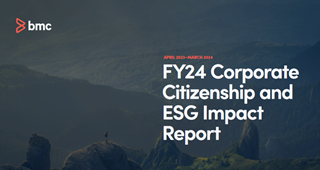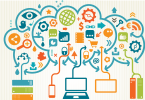Sustainability is defined across three dimensions: social, economic, and environmental. As businesses continue to adapt their operational models for post-pandemic planning, environmental, social, and governance (ESG) initiatives are becoming more important for present and future employees, stakeholders, and customers.
But what does this mean, exactly?
ESG is a wide-ranging topic, and in the IT field, it encompasses everything from the employee experience to ethical IT. For the purpose of this piece, let’s focus on the concept of sustainability. When we talk about tech, we’re thinking about hardware—the personal and enterprise devices that are omnipresent in our daily lives—and the software that runs behind the scenes to keep all those devices from becoming expensive paperweights.
First and foremost, organizations must talk about change alongside practicable efforts to enact it—and validate and ensure accountability for those efforts by measuring them against standards like the 17 United Nations Sustainable Development Goals and the Carbon Development Project (CDP). Today’s customers want to see that businesses are doing what they say they’re doing—and they’re putting their decision-making muscle behind those desires.
PwC research found that 79 percent of consumers are more likely to buy from a company that stands up for ESG practices, and 84 percent of workers are more likely to work for those companies.
At our annual BMC Exchange customer event, I recently moderated a panel with BMC decision-makers in a session about how to practice and plan for ESG. Here are some of the takeaways from my discussion with BMC’s own ESG thought leaders: AVP of Experience Design and Development Mark Fries; Vice President of Research and Development Srini Packirisamy, Senior Principal Solution Engineer Des Sanders; and Strategic Field CTO Craig Sisson.
Security and governance
Security and governance go hand in hand, and they’re bleeding into societal concerns because breaches go beyond the business to also affect the individual consumer. Organizations can face significant fines, lose customers’ confidence, or ruin their brand if they have a security breach that exposes corporate and customer information.
And that security lapse extends to customers who can then face phishing attempts, credit fraud, stolen credentials, identify theft, and more. Part of ensuring a secure environment across a business and for everyone the business touches means putting secure practices around governance, and implementing real-time, ongoing vulnerability detection solutions. These measures create the assurance (never a guarantee!) that companies are intent on protecting their customers and communities. Building a robust security posture is part of becoming an Autonomous Digital Enterprise, too. In fact, one of the tenets of that forward-looking business framework is Adaptive Cybersecurity.
Reducing the carbon footprint
Another area where employees, customers, and stakeholders are weighing their business considerations is whether, and how, the companies they engage with are actively working to reduce their carbon footprint and greenhouse gas emissions. They want to know that companies are planning for the future state of the world beyond their business.
Take, for example, today’s data centers—they have servers running, HVAC systems to keep them cool, and significant electricity requirements, and all of these things generate carbon emissions. By adding sensors and monitoring solutions to that environment, organizations can monitor and measure emissions, and analyze that data to better optimize their infrastructure and reduce its footprint.
Migrating to the cloud, or scaling or rightsizing that environment, is a solid first step but only part of the equation. Businesses can also expand the scope of inquiry to include transportation, supply chain, partners—and focus on collecting and analyzing those complex data streams. That’s where automation solutions such as Control-M from BMC come in handy to orchestrate data pipelines; ingest the data; and correlate, optimize, and understand it.
From there, organizations can also perform ongoing analysis and leverage those insights with tools like BMC Helix Continuous Optimization to guide decision-making on smarter infrastructure and better business processes that reduce greenhouse gases. Once the necessary steps are identified, it also helps to have a methodology in place to forecast the carbon footprint going forward over the next five to ten years and beyond.
BMC is demonstrating its commitment to that future by declaring its intent to reach net-zero value chain emissions no later than 2030. BMC is also part of the Business Ambition for 1.5° C campaign and is a proud member of the UN Global Compact, which established the campaign alongside the Climate Disclosure Project (CDP), the World Resources Institute (WRI), and the World Wildlife Fund (WWF) under the umbrella of the Science Based Targets Initiative (SBTi) partnership.
Ethical IT and the circular economy
In the world of hardware—whether you build it, sell it, or use it—being mindful of its entire lifecycle and making ethical decisions at every step has an impact. The first step a company can take is to re-examine its IT asset lifecycle model, as well as that of any third-party vendors involved in the process, to ensure best practices around the circular economy, ethical disposal, and alignment with sustainability goals.
This not only helps a company’s bottom line, but also enables it to be a responsible user of global resources. Some of the ways every business can support ethical IT include selecting products that are designed with recycled or ocean-bound plastics; maximizing their working life; and recycling and upcycling devices at end of life to keep them out of landfills when they’re replaced.
As a personal consumer, keep those same considerations front of mind. According to a recent study by the United Nations Institute for Training and Research (UNITAR) and the WEEE Forum, 5.3 billion of the 16 billion mobile phones possessed worldwide will become waste in 2022—and if stacked one on top of the other, they’d stretch one-eighth of the way to the moon.
You can help by making responsible decisions at the point of purchase and extending the life of your devices whenever possible. Replace the battery, and move all those images to the cloud or delete unused apps to get back some of your storage space before you go buy another phone.
And when you do replace your phone, don’t put the old one in a drawer or randomly throw it away. You can repurpose it for the greater good. Some of the organizations that BMC and our employee volunteer organization, BMC Cares, support include Medic Mobile, the 911 Cell Phone Bank, the National Coalition Against Domestic Violence, DV Safe Phone, and Community Calling, which deploy devices into communities that need them. If you’re planning to toss your phone, look for a licensed recycler that will ethically, responsibly dispose of both the device and its toxic components that can contaminate the earth, groundwater, and waterways—and endanger flora, fauna, and people.
Build better code
During the session, Srini shared that he and his team follow the Karlskrona Manifesto for Sustainability Design, which adheres to the idea that humans can only reach sustainability if they’re sustained across social, economic, and environmental dimensions. In his work at BMC, he and his team have adopted modern, agile software development methodologies for BMC’s software solutions, placing more emphasis on modular code and reuse of code and leveraging a Kubernetes and microservices architecture for BMC’s software-as-a-service (SaaS) offerings. BMC is also using artificial intelligence (AI)-driven innovations in its DevOps environments to optimize resource efficiency.
Software ownership, which includes development, operation, and maintenance costs, also has opportunities for improvement through automation. Automating testing, maintenance, and continuous deployment processes can help organizations achieve better sustainability by reducing energy consumption.
For web usage, organizations can consider the data load of the web pages they create to improve the energy consumption involved in the storage of hosting those pages—and for users to access. Focus on experiences that provide value for end users and the environment.
According to the 2022 Edelman Trust Barometer, 58 percent of respondents will buy or advocate for brands based on their beliefs and values, and 60 percent will use that criteria when choosing an employer. With ESG a growing part of a global belief and value system, it’s no longer a nice to have; it’s now a must-have.
Watch the full BMC Exchange 2022 session here.
Originally published in Triple Pundit.







